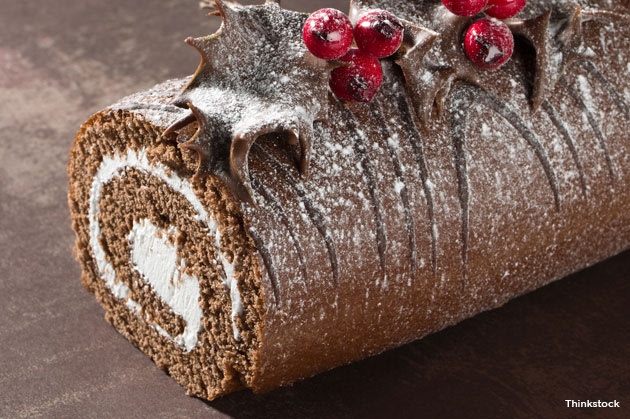Tradition has be on going for a long long time that we eat certain delicacies during certain festive seasons. This Christmas maybe besides eating all the traditional goodies, you may want to know about the history and significance of eating them!

Bûche de Noël, AKA "Log Cake"
A common holiday cake served in countries that were at one point a French colony, the Bûche de Noël, or "yule log", is a cake prepared and decorated to look like, well, a log. It's supposed to symbolize the log used in the fire festival of the winter solstice. Yes, winter solstice. While the cake's name has "Noël" in it to refer to the birth of Jesus, it turns out, the tradition is rooted in 6th century Anglo-Saxon paganism. No surprise there: the yule log is just one of two Christmas observances that originated from paganism. The other would be mistletoe.
Candy canes
This sickly sweet treat originated in Europe during the 17th century. The Christians back then had just adapted the Christmas tree, and as ornaments, used cookies and sugar sticks. It was in 1670 when a German choirmaster decided to bend one end of the stick, supposedly to represent a shepherd's staff. The treat was handed out to children during the long Christmas Mass, and the tradition of handing out candy canes to kids was passed on to the Americans. But back then, the humble candy cane was stripe-less: think a plain white sugar stick with no flavoring at all. No one knows who added the stripes to the candy cane, but Christmas cards printed before the 1900's showed plain white canes—those printed after 1900 has striped canes. Wintergreen and peppermint flavors were added to the candy around the same time it earned it stripes!
Gingerbread
Gingerbread goes waaaay back to the ancient Greeks and Egyptians, who used it for ceremonial purposes. But the cookie that we know and love today can be traced back to the 11th century, when spices were being discovered in the East—because of its rarity, only rich European folk could enjoy the treat. When gingerbread finally became affordable to the masses, it was pressed into wooden molds and decorated with white icing. (Or gold, if you could afford it!) The first gingerbread man was actually a woman—Queen Elizabeth I, to be exact. Apparently, to impress some visiting dignitaries, she had one made in her own likeness. Since then, gingerbread men were sold at fairs. Oddly enough, crumbled gingerbread was also used to mask the odor of decaying meat.
Eggnog
Possibly the only alcohol children are allowed to drink (well, at least just a little bit!) around the holiday season, eggnog is a Christmas tradition that goes back to the 17th century. Literally meaning "egg in a cup", it was used to toast to one's health (the Brits, however, call the drink "egg flip," as they "flip" the mixture between two pitchers to mix it). Eggnog used to be the trademark drink of the upper class, since they were the only ones who could afford milk. It became widespread in America, since milk was easily accessible there. If you're planning on making your own egg nog and are worried about salmonella, use pasteurized eggs, or cook the eggs into a custard to ensure all salmonella bacteria is killed.
Fruitcake
Also known as the world's most gift-recycled food item during the holidays, since they're notorious for staying edible for years. People reckon the first fruitcakes (at least the ones that we know of and enjoy today) were made in the 13th century, around the time dried fruits arrived in Britain. Since then, fruitcakes were used in important celebrations, such as weddings. To say making fruitcake in the 18th century was hard to make is an understatement—fruit had to be washed, dried, and stoned. Butter was washed in water then in rosewater, and the eggs were beaten for half an hour or so. While there are machines that can do this work for you today, bakers still make the cake months in advance in order for the bread to soak in the alcohol—which also acts as a strong preservative. How strong? Well, an article published in the New York Times in 1983 tells a story of a woman who inherited the family heirloom: a then-86 year old fruitcake, baked by her great-grandfather back in 1794.
Now you know. Merry Christmas to all! Loves! (",)
No comments:
Post a Comment